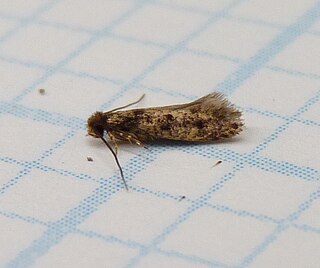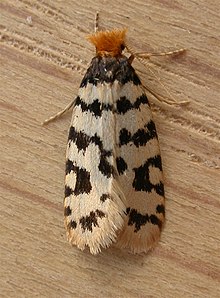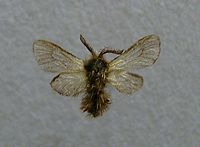
Lepidoptera or lepidopterans is an order of winged insects that includes butterflies and moths. About 180,000 species of the Lepidoptera have been described, representing 10% of the total described species of living organisms, making it the second largest insect order with 126 families and 46 superfamilies. and one of the most widespread and widely recognizable insect orders in the world.

The evergreen bagworm, commonly known as bagworm, eastern bagworm, common bagworm, common basket worm, or North American bagworm, is a moth that spins its cocoon in its larval life, decorating it with bits of plant material from the trees on which it feeds.

The luna moth, also called the American moon moth, is a Nearctic moth in the family Saturniidae, subfamily Saturniinae, a group commonly named the giant silk moths.

Attacus atlas, the Atlas moth, is a large saturniid moth endemic to the forests of Asia. The species was described by Carl Linnaeus in his 1758 10th edition of Systema Naturae.

Saturniidae, members of which are commonly named the saturniids, is a family of Lepidoptera with an estimated 2,300 described species. The family contains some of the largest species of moths in the world. Notable members include the emperor moths, royal moths, and giant silk moths.

Antheraea polyphemus, the Polyphemus moth, is a North American member of the family Saturniidae, the giant silk moths. It is a tan-colored moth, with an average wingspan of 15 cm (6 in). The most notable feature of the moth is its large, purplish eyespots on its two hindwings. The eyespots give it its name – from the Greek myth of the cyclops Polyphemus. The species was first described by Pieter Cramer in 1776. The species is widespread in continental North America, with local populations found throughout subarctic Canada and the United States. The caterpillar can eat 86,000 times its weight at emergence in a little less than two months. Polyphemus moths are considered to be very polyphagous, meaning they eat from a wide variety of plants.
The wattle bagworm is a species of moth in the family Psychidae. In southern Africa it is a pest of the black wattle which is grown largely as a source of vegetable tannin. Kotochalia junodi is indigenous to Southern Africa, where it originally fed on indigenous relatives of the wattle.
Eumeta crameri is a bagworm moth of the family Psychidae. It was described by John O. Westwood in 1854 and has worldwide distribution in tropical and subtropical habitats, including India, Bangladesh, Sri Lanka, New Zealand and Puerto Rico.

The Coleophoridae are a family of small moths, belonging to the huge superfamily Gelechioidea. Collectively known as case-bearers, casebearing moths or case moths, this family is represented on all continents, but the majority are found in temperate areas of the Northern Hemisphere. They are most common in the Palearctic, and rare in sub-Saharan Africa, South America, and Australia; consequently, they probably originated in northern Eurasia. They are relatively common in houses, they seek out moist areas to rest and procreate.

Phereoeca uterella, known by the vernacular names plaster bagworm and household casebearer, is a moth species in family Tineidae. It occurs in tropical climates, where it is common in houses, and is presumed native to the Neotropical realm. In the Americas, it has been recorded from Brazil, Guyana, and the southern United States as well as the Virgin Islands and Trinidad, and tentatively identified from Tobago.

Abantiades latipennis, known as the Pindi moth, is a species of moth in the family Hepialidae. It may also be referred to as a swift moth or a ghost moth, as this is a common name associated with Hepialidae. Endemic to Australia and identified in 1932, it is most populous in temperate rainforest where eucalypti are prevalent, as the larvae feed primarily on the roots of these trees. Females lay eggs during flight in a scattering fashion. The larvae live for over eighteen months underground, while adult moths survive for approximately one week, as they have no mouthparts with which to feed. The moths are preyed upon by a number of predators, including bats and owls. Brown in colour overall, males are paler and the identifying silver bars of the male's wings are more prominent than those of the female's, with dark margins. Male adults are generally smaller.

The external morphology of Lepidoptera is the physiological structure of the bodies of insects belonging to the order Lepidoptera, also known as butterflies and moths. Lepidoptera are distinguished from other orders by the presence of scales on the external parts of the body and appendages, especially the wings. Butterflies and moths vary in size from microlepidoptera only a few millimetres long, to a wingspan of many inches such as the Atlas moth. Comprising over 160,000 described species, the Lepidoptera possess variations of the basic body structure which has evolved to gain advantages in adaptation and distribution.

Apterona helicoidella is a moth of the Psychidae family. It is widely distributed in Europe, from Portugal through most of central Europe and the Alps up to the Ural. It is also found in the Balkan and Turkey. It was introduced in the United States by accident during the 1940s. It is now found in many mid-Atlantic states, including Pennsylvania, and has also been reported in the Pacific coastal states, Colorado, Michigan, Nevada, Utah and Idaho. It has also been collected in Ontario.

Metura is a genus of bagworm or case moths in the family Psychidae, endemic to Oceania. The genus contains the largest species of Psychidae known, M. aristocosma, with a larval bag of up to 300 mm and an adult male wingspan of 60 mm.

Liothula omnivora, the common bag moth, is a psychid moth endemic to New Zealand. It is also known by several Māori vernacular names like the tūngou ngou,< whare atua or kopi ('shut').
Eumeta variegata, commonly known as the paulownia bagworm or cotton bag worm, is a moth of the family Psychidae. The species was first described by Snellen in 1879. It is found in Japan, Papua New Guinea, India, the Solomon Islands and Sri Lanka.

Metisa plana is a moth of the family Psychidae first described by Francis Walker in 1883. It is found in Sumatra, Malaysia and Sri Lanka. It is a major pest on Elaeis guineensis, the African oil palm.

Pteroma plagiophleps is a moth of the family Psychidae first described by George Hampson in 1892. It is found in India, Bangladesh, Sri Lanka, and Indonesia.
Mahasena corbetti, the coconut case caterpillar, is a polyphagous species of bagworm. This species is classified as leaf-eating pest caterpillars that produce tough silk out of their bags from dried foliage. Currently, M. corbetti is considered a 'pest of quarantine importance' in multiple countries and is included on the list of dangerous pests in the Malaysian plant quarantine act.
Pteroma pendula, the oil palm bagworm or simply bagworm, is a species of bagworm moth found in East and Southeast Asia that infests oil palm plantations.





















